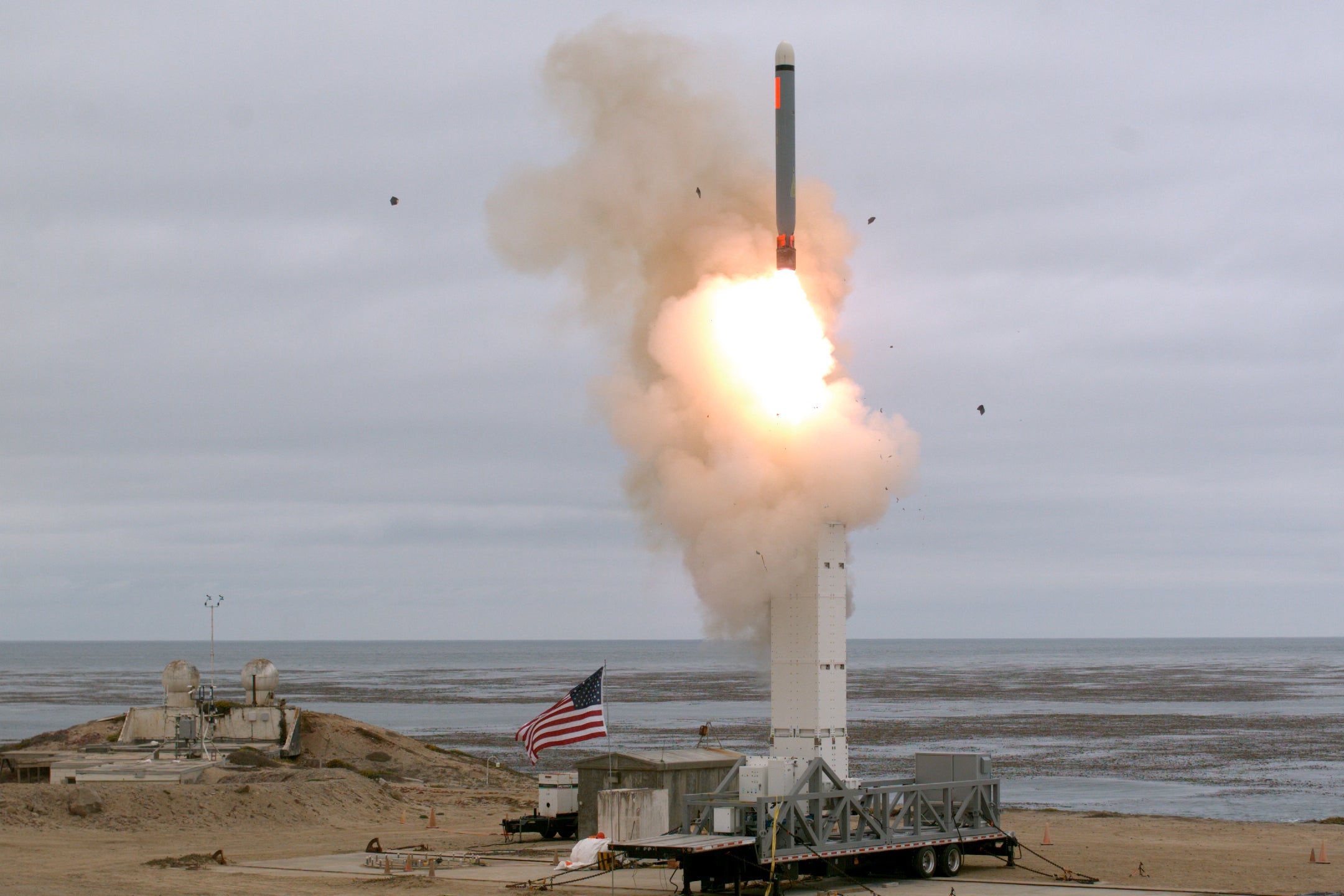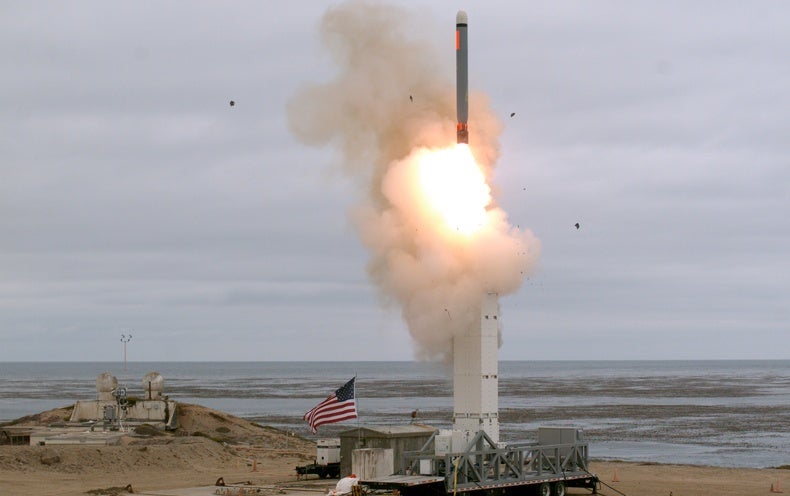
Russia recently attacked Kyiv with a cruise missile in a menacing demonstration of Moscow’s ability to carry out a long-range strike against a metropolitan target. The successful assault exposed vulnerabilities in Ukraine’s air defenses—and highlighted similar gaps in those of the U.S. Now the Pentagon wants to test technology that it hopes can defend American cities against the very same type of weapon.
This experiment, a proposed 2023 event called the Cruise Missile Defense–Homeland Kill Chain Demonstration, would combine existing technologies in an effort to better shield cities and critical infrastructure from cruise missiles. “I need [a domestic cruise missile defense system] yesterday, candidly,” says Gen. Glen VanHerck, commander of North American Aerospace Defense Command (NORAD) and head of U.S. Northern Command, who is responsible for protecting the U.S. and Canada against such weapons. “The threat exists today, primarily from Russia,” he says. The four-star general warns that Moscow’s current technology would enable it to attack American targets from within Russian territory or from ships off U.S. shores. And the problem is not limited to Russia. In “five to 10 years,” VanHerck says, “we’ll be in the same place with China.”
The Problem with Cruise Missiles
A cruise missile is an uncrewed aerial vehicle designed to attack a fixed target. It spends most of its flight at a level elevation and follows a preprogrammed path to impact. Cruise missiles are powered by jet engines. Ballistic missiles, by comparison, fly a largely unpowered parabolic trajectory—like that of a fly ball coming off a baseball bat—after being propelled by an initial rocket boost.
Dealing with the threat of cruise missiles presents two especially difficult challenges, explains Patty-Jane Geller, a missile defense expert at the Heritage Foundation. “First, they’re really difficult to detect and track,” Geller says. “Cruise missiles fly at lower altitudes than ballistic missiles, which most of our sensors—both space- and land-based—are designed to detect. They also don’t fly superfast.” If a cruise missile is traveling over U.S. territory, she says, “how do we know it’s not a domestic plane?” The second problem, Geller says, arises because cruise missiles can be armed with nonnuclear warheads. “They give Russia and China a capability to wage a strategic attack … that’s below the nuclear threshold.” The possibility of this kind of conventional attack weakens a crucial pillar of U.S. defense policy: nuclear deterrence.
Russia has already fielded a new family of advanced air-, sea- and ground-based cruise missiles that could threaten critical civilian and military infrastructure, senior Pentagon officials say. In a future conflict, these weapons could be used to attack American airfields, ports and utilities. They could even threaten locations with economic significance, such as major cities, in an effort to thwart the deployment of U.S. forces to an overseas fight.
Experts say a few of these new weapons raise particular concern. One is Russia’s Kh-101 air-launched cruise missile. It boasts an extended range of nearly 2,500 miles, enabling bombers flying well outside NORAD radar coverage to threaten North America—in some cases even from within Russian airspace. “This capability challenges my ability to detect an attack and mount an effective defense,” VanHerck says.
Other related military technology is also creating headaches for NORAD. Earlier this month U.S. Defense Intelligence Agency director Lt. Gen. Scott Berrier warned Congress that “in the coming months” Russia will field a pair of new, ultraquiet attack submarines that can carry cruise missiles. Berrier said these craft, the Kazan and Novosibirsk, are capable of threatening North America from the Pacific.
Defense Measures
Cruise missile defenses—and air defenses in general—consist of three main components: sensors that detect an incoming threat, shooters that attempt to knock it out of the air and battle management systems that act as the brains controlling the whole process. The latter have to first identify a missile, then calculate a trajectory to intercept it, and finally launch and guide an interceptor (such as another missile) to destroy the incoming weapon.
The U.S. military already has well-established systems to protect ships and forces deployed in the field against these weapons. The Army’s Patriot system, for example, became a household name after its debut during the 1991 Gulf War. At sea, Navy cruisers and destroyers outfitted with SPY-1 radar and the Aegis combat system can counter cruise missiles with the Standard Missile-6. But there are relatively few of these assets, and they are in high demand.
This is why the Department of Defense would prefer to preserve its inventory for use in possible overseas operations rather than tying that inventory down protecting, say, Los Angeles, New York City or other vulnerable population centers. In fact, the only domestic location currently protected by round-the-clock cruise missile defense is Washington, D.C. After the terrorist attacks of September 11, 2001, the Pentagon created this bespoke cruise missile defense capability as part of what is called the National Capital Region Integrated Air Defense System architecture. But this system is limited to the local area and relies on technology acquired from Europe (its centerpiece is called the National/Norwegian Advanced Surface to Air Missile System).
Domestic Protection
VanHerck wants to work with the Missile Defense Agency, or MDA—a Department of Defense group that develops new capabilities to counter advanced threats—to build a broader cruise missile defense system that will be tailored for domestic operations by putting together modified versions of existing technologies. This hybrid system could presumably be less rugged, and therefore less costly, than those used for military expeditions abroad. As a starting point VanHerck has proposed the Cruise Missile Defense–Homeland Kill Chain Demonstration. In April he asked Congress for $50 million for the project. This would be in addition to President Joe Biden’s fiscal year 2023 budget, which requested funding for a number of measures to enhance cruise-missile-warning capabilities—including $278 million for new, over-the-horizon radars to improve detection.
If Congress approves VanHerck’s $50-million request, part of the funds will go to the sensor component, a type of radar, for the proposed new domestic system. The most consequential factor determining a cruise missile defense system’s effectiveness is a sensor’s radar range—which is heavily influenced by how high above the ground it sits. A recent government study found the minimal elevation for an effective tower-based radar sensor is 700 feet above sea level, including terrain elevation. For homeland cruise missile defense sensors, VanHerck specifically wants to demonstrate a tower-mounted radar that can detect an incoming missile’s coordinates. Then the detector—in this case, something called an x-band sensor—would deliver these data to a battle management system, which would direct a missile to intercept the threat. X-band refers to the section of the electromagnetic spectrum that works best for scanning the horizon. Mounted on a tower, the x-band sensor would provide high-fidelity tracking of all air traffic, as well as electronic identification to distinguish between incoming missiles and routine objects such as civilian planes.
The rest of VanHerck’s $50-million request for the demonstration would support three sessions of one-week exercises at the White Sands Missile Range in New Mexico. These experiments would link the tower-mounted radar—the Pentagon says it will use an existing x-band sensor as a surrogate during the demonstration—with existing shooters and battle management systems. In preparation for the proposed 2023 demonstration, the MDA must first conduct a series of simulated cruise missile intercepts. So the agency is developing new connections to allow existing technologies, which were not originally designed to work together, to function as an effective system. The MDA is working with private companies on this task: In November the agency signed contracts with aerospace companies Northrop Grumman and Numerica Corporation, and it is currently finalizing terms with Raytheon. These companies aim to help the MDA demonstrate a simulated system that VanHerck would then be able to use in a live-fire demonstration.
“The deliverables will consist of software modifications necessary to conduct a simulated engagement within the National Capital Region Integrated Air Defense System architecture,” says MDA spokesperson Heather Cavaliere.
VanHerck says he does not have a preconceived idea of what the best missile-defense solution will ultimately look like. Instead he hopes the 2023 event he is advocating will spur creative thinking. That could involve new twists on current tactics—such as debilitating an incoming cruise missile with a high-powered electromagnetic weapon or developing other alternatives to simply shooting a missile at a missile.
“What I want industry, what I want the Missile Defense Agency and the services to do,” he says, “is let their minds run wild on capabilities to accomplish this mission.”
























































